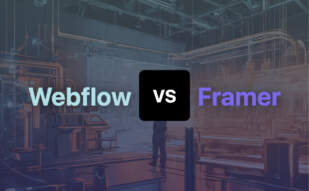For those requiring SEO control, design freedom, and robust e-commerce options, Webflow stands out. It’s a top choice for web designers, agencies, and creators due to enhanced customization. However, Squarespace is ideal for visually-driven sites needing simplicity and ready-made, beautiful templates with solid e-commerce capabilities.

Key Differences Between Webflow and Squarespace
- Webflow offers total design control with live prototyping; Squarespace focuses on delivering visually appealing websites with expertly curated templates.
- Webflow’s comprehensive e-commerce platform is customizable down to the cart and checkout experiences. Squarespace provides a basic but efficient e-commerce platform.
- The transactional process in Webflow is handled via Stripe, PayPal, Apple Pay, Google Pay. Squarespace also integrates multiple payment gateways but offers offline selling via Square integration.
- Webflow opens up SEO control, automatic meta title, and description. Squarespace’s SEO aspects are built-in and less flexible.
| Comparison | Webflow | Squarespace |
|---|---|---|
| Platform Descripton | Ecommerce platform for custom website creation without coding | Website builder platform with focus on aesthetically appealing templates |
| Product Types Supported | Physical, digital goods and services | Physical, digital goods and services |
| Customizable Experiences & Design Control | Yes, with customizable product fields, cart, and checkout experiences | Yes, with Squarespace Blueprint for customizing template designs |
| Analytics & SEO | Built-in Google Analytics integration. SEO control supports automatic meta title, description generation | Powerful analytics tools for visitor/sales tracking. SEO optimized |
| Customer Engagement | Blogging feature for customer conversion and SEO | Blogging platform for driving customer engagement. Email campaigns, Social Media marketing |
| Inventory Management | Sync integrations, order management dashboard | Centralized content manager with no transaction limit |
| Transaction Management | Automatic tax calculation, sales tax, VAT. Quick order refund | Automatic transactional emails, tax rules setup based on regions |
| Customer Support & Learning | Webflow University for video tutorial classes. Client-friendly dashboard | Email, Twitter, Live chat. Squarespace Blueprint for template customizations. Marketplace for hiring experts |
| Email Marketing | Integration with Mailchimp | Integration with Mailchimp |
What Is Webflow and Who’s It For?
Webflow is a dynamic eCommerce platform that allows you to create websites without a line of code. It gives complete control over customized design for presenting physical items, digital goods, and services. Thanks to features like customizable product fields, cart, and checkout experiences, Webflow offers complete design control, painting a digital canvas for your brand representation. Loved by designer aficionados like Maximilian Müsgens and Charli Marie, Webflow eCommerce is a haven for web designers, web agencies, and content creators.

Pros of Webflow
- Enhanced design capabilities
- Integration methods with native interfaces or third-party apps
- Automated shipping processes, accounting, and notifications
- Built-in Google Analytics for data insights
- Complete customization with no coding
Cons of Webflow
- Prices could be high for small businesses, starting at $29/mo
- Transactional fees through Stripe
- Limited offline selling option through POS integration
What Is Squarespace and Who’s It For?
Squarespace is a website building platform renowned for deliverance of visually appealing websites. A platform tailored for artists, it brings aesthetics and functionality together in website and online store creation. It’s resources range from expertly curated website templates to powerful ecommerce tools. Whether it’s physical items, digital goods, or services, Squarespace seeks to help creators and businesses elegantly share their narrative with the online world.

Pros of Squarespace
- Proficient templates for visually appealing sites
- Integrated shopping cart, multiple payment gateways
- Powerful analytics for tracking visitor behavior
- Scheduling appointments, selling classes, subscription products
- 24/7 customer support
Cons of Squarespace
- May lack the customization flexibility compared to Webflow
- Additional features like carrier calculated shipping, abandoned cart recovery in the higher-priced plan
- Dependent on third-party carriers for shipping connectivity
The Final Word on Webflow vs Squarespace
When venturing into the digital sphere, the right tools make a world of difference. With detailed considerations, we arrive at a verdict of Webflow vs Squarespace.
Web Designers and Agencies
Webflow’s rich feature set, advanced design capabilities, and customization stands out for this audience. The tools offer less restriction and more control. Moreover, customizable product fields, cart and checkouts enhance user experience.Webflow is the go-to choice for these professionals.

Bloggers and Content Creators
Squarespace’s strong array of templates and easy-to-host blogging platform provide bloggers an edge. With the added advantage of SEO and Mailchimp integration, crafting and managing blogs is much simplifed. Squarespace takes the cake for Bloggers and Content creators.

E-commerce businesses
Webflow’s expansive e-commerce functionalities including inventory sync integrations, automated shipping processes, and real-time tax calculations provide a comprehensive solution for online businesses. With options for offline sales and POS integration, it offers a robust platform for e-commerce. Webflow is a clear winner for e-commerce businesses.

In the arena of ‘Webflow vs Squarespace’, if you seek advanced design capabilities, customization without constraints, and robust e-commerce functionalities, Webflow emerges victorious. Squarespace shines with its user-friendly templates and blogging platform but falls short on advanced features. Considering the core tools you require, decide the champion for your needs.
Hannah Stewart
Content writer @ Aircada, tech enthusiast, metaverse explorer, and coffee addict. Weaving stories in digital realms.





